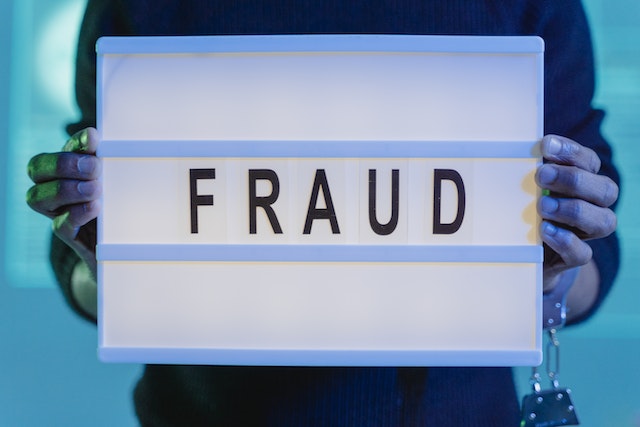Fraud is one of the most common crimes committed against businesses. It involves deception in order to unlawfully extort money or gain access to sensitive information. There are many different types of fraud – practically hundreds of different types in fact. However, there are some that are much more common and dangerous than others. Below are 10 examples of these types of fraud and how to protect your business against them.
Email phishing
Email phishing is arguably the most common type of fraud that businesses encounter. It is when a cybercriminal poses as someone trusted (such as a bank, government agency, insurer, supplier or even a client) via email in order to steal money or get you to spill sensitive information.
Most email providers are able to detect obvious attempts at phishing and filter them directly into your spam folder, while others can warn you if an email seems suspicious. While this can protect you from the bulk of phishing attempts, some fraudulent emails may still find their way into your inbox. Use your instincts to detect when something seems off – if an email seems suspicious, do not click on any links, and do not reply to it. Always check the sender’s address to see if it is legitimate. If you’ve received a random request for money (including an invoice) for a fee or bill that you weren’t aware of, consider contacting the party via a phone number on their official website (do not use the phone number supplied in the email) to confirm that the payment request is real.
Refund abuse
Refund abuse is when a customer tries to demand a refund for a product by making false claims (such as that it was damaged when it arrived or that it was never delivered). It is very common in retail, hospitality and e-commerce. By fraudulently asking for a refund, such customers are then able to essentially enjoy the product for free.
There are measures you can take to prevent refund abuse. Asking the customer to return the product for inspection – whether it’s taking a dish back to the kitchen or shipping a product back to its origin – is the best way to check if a product is truly damaged or not up to standard. As for claims that a product was never delivered, you may be able to argue this case by making sure that the courier asks for a signature or takes a photo of the product on arrival.
Friendly fraud
Friendly fraud is anything but friendly. It is similar to refund abuse in that a customer requests their money back by making false claims. However, instead of contacting you for a refund, they contact their bank or credit card provider and file a chargeback. A fraudster may claim that their card was stolen when they made the purchase or that the product was damaged and that they’ve been denied a refund. Their bank/credit card provider then refunds them and files you a chargeback fee (which is typically more expensive than a refund).
This type of fraud is much harder to prevent because the customer goes through their bank/card provider instead of you. However, you can still reduce the risk of it happening by monitoring chargebacks using chargeback management software. Such software can alert you when a chargeback is filed and let you know where it came from so that you can contest it if you think it is fraudulent. This article explains more about how chargeback management software works.
Credit card fraud
Credit card fraud occurs when a criminal uses stolen card/card details to make a payment. This can result in you losing money when the card owner finds out and files a chargeback.
The best way to prevent credit card fraud is to introduce security measures to authorize and monitor payments. When it comes to preventing online credit card fraud, you can stop fraudsters from paying via stolen credit cards by using a secure payment gateway. Passwords and confirmation emails can also provide an added barrier of security. As for protecting your business against in-person credit card fraud, consider installing cameras near your checkout so that you can record footage of every customer – if a person claims their credit card was stolen, security camera footage in your premises can be checked by police and you and the card owner may be able to be compensated.
Counterfeit money
There is a lot of counterfeit money in circulation. A customer may knowingly or unknowingly pay you using this money. When you go to cash it in your bank, you could then find that it is not accepted, resulting in you losing money.
To avoid accepting counterfeit money, you should always inspect bank notes before accepting them. UV counterfeit money checkers are used by many stores to help check that a note is real – consider buying these if you accept a lot of cash.
Personal injury fraud
Personal injury fraud occurs when a customer or member of the public falsely claims that they were injured as a result of your business. Fraudulent slip and fall injuries are most common – a fraudster with a pre-existing injury may pretend to slip on your floor and then file a lawsuit claiming that the injury was your fault.
It’s quite hard to prevent these claims, however, you may be able to defend yourself against a false claim if you have security video footage that shows the fall was clearly faked. Using signage to point out hazards (such as a ‘mind your head’ sign above a door or a ‘caution wet floor’ sign in front of the wet floor) may help minimize the success of these lawsuits. Better still, take measures to eliminate any hazards that an opportunistic fraudster could take advantage of.
Worker’s compensation fraud
Worker’s compensation fraud is a form of personal injury fraud, but it is committed by an employee instead. An employee fakes an injury or sickness and then claims compensation which is paid by your insurer. While it is largely the insurance company that gets screwed, a claim could still result in higher insurance rates for you in the future and may be damaging to your reputation.
As with personal injury fraud, you should prevent opportunistic worker’s compensation fraudsters by eliminating as many hazards as you can from your workplace. Monitoring your workplace with security cameras can also help to potentially capture evidence of a false claim.
Skimming
Skimming is a form of fraud that is also typically committed by an employee. It involves secretly taking money from the business before it is registered into an accounting system. This could include pocketing cash rather than putting it through a cash register or even getting a customer to pay an invoice to a personal account instead of a company account.
Skimming is hard to detect without closely monitoring employees. Security camera footage or screen recording software may be able to capture evidence of skimming incidents and may be your best defense (just make sure to notify employees that you are recording them). Tighter applicant screening measures may also be able to prevent skimming such as asking for previous employer references and doing a criminal background check to ensure there are no previous cases of fraud.
Payroll fraud
Payroll fraud occurs when an employee lies or manipulates a payroll system in order to receive more pay than they legally owe. This could include using timesheets to lie about the hours they’ve worked or hacking into payroll software to adjust their pay.
Using up-to-date payroll technology, it’s generally much harder for an employee to commit payroll fraud. Time clock apps combined with screen monitoring or video cameras can accurately monitor when an employee starts work and ends work so that no employee cannot lie about how many hours they’ve worked. Meanwhile, restricting access to payroll software and adding passwords can prevent employees from accessing it and manipulating figures.
IP theft
IP theft is the theft of intellectual property, which could include ideas, creative expressions, and inventions. Common examples in business include the theft of a brand name, logo, photographs, website copy, or an invention. There are many ways in which such intellectual property can be used unfairly such as stealing ideas in order to steal customers or even deliberately damaging a brand’s reputation.
Intellectual property may be freely available to use by other people unless it is protected by copyright, trademarks or patents. All original content shared online is automatically copyrighted under the Digital Millennium Copyright Act. Trademarks on branding and patents on inventions meanwhile need to be applied for separately. Consider whether it could be worth applying for trademarks and patents so that it’s easier to defend yourself legally against IP theft. There are tools you can use to check for stolen online content, as well as measures you can take to prevent theft such as buying up domain names that are similar to your website.


Leave a Reply